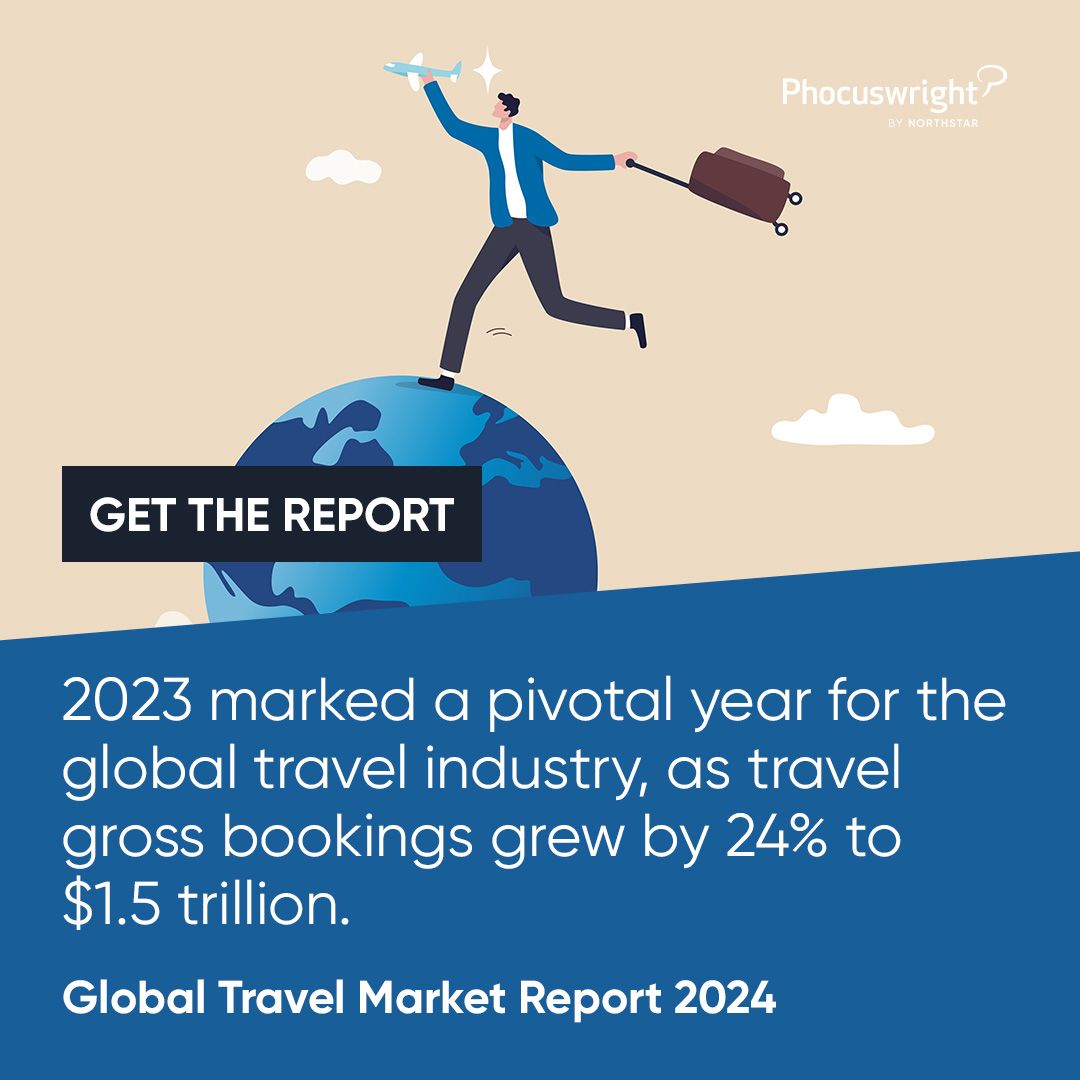Phocuswright Research Roundup 3Q24
An overview of the research reports published in 3Q24.

It was another packed quarter for Phocuswright analysts, with 20+ publications spanning technology trends, global travel market sizing, social creator and influencer analysis and more. Phocuswright continues to add to its massive collection of insights and news that powers the travel industry.
Here's a recap of the insights, data and more. (Click on each report title to access the report).
Technology Trends

While DMA enforcement is in its very early stages, changes made in response to the regulation are already disrupting the status quo for travel businesses, including some European hotels.
Report preview: How the EU Digital Markets Act (DMA) Will Impact Travel

What Google’s Cookie Reversal Means for Travel
Google's decision to reverse its plan to eliminate third-party cookies from Chrome offers a temporary reprieve for travel advertisers. However, it highlights the growing emphasis on privacy and the need for alternatives like first-party data and contextual advertising. While third-party cookies remain for now, they are unlikely to be a long-term solution. Travel brands must continue to invest in diverse, privacy-focused strategies to stay competitive in the evolving digital landscape.
Key questions answered by this research include:
- What does Google's reversal on eliminating third-party cookies mean for advertisers in the travel industry?
- How can travel companies adapt to a future with diminishing reliance on third-party cookies?
- What are the key alternatives to third-party cookies that travel advertisers should explore?
- How will privacy concerns and regulatory pressures continue to shape digital advertising strategies?
What long-term strategies should travel companies prioritize to future-proof their digital marketing efforts?
How the EU Digital Markets Act (DMA) Will Impact Travel
Gone are the days of the tech monolith? The EU’s Digital Markets Act (DMA) aims to curb Big Tech’s power by imposing strict rules on the biggest gatekeeper companies. While the legislation seeks to promote competition and protect consumers, its impacts on the travel industry are complex and unpredictable. Early enforcement has already led to significant changes in how companies like Google and Booking.com operate in Europe, affecting everything from search results to pricing strategies. As the DMA unfolds, travel businesses must navigate a shifting landscape of compliance, innovation challenges, and evolving competitive dynamics.
Key questions answered by this research include:
- What is the Digital Markets Act (DMA), and how does it regulate large digital platforms?How will the DMA’s requirements and prohibitions impact major travel industry players, including OTAs and hotels?
- What are the potential unintended consequences of the DMA on competition, innovation, and market dynamics in travel?
- How could changes in search engine results and rate parity affect the travel industry’s distribution landscape?
Google Chrome is the world’s most popular web browser, with 64% market share as of July 2024, and advertising is Google’s (Alphabet’s) largest revenue stream. Therefore, Google’s stance on third-party cookies is highly consequential for the company as well as a substantial portion of the online public.
Report preview: What Google’s Cookie Reversal Means for Travel

CBDCs Are Coming: Is the Travel Industry (and the World) Ready?
As Bitcoin reclaims its zenith and the buzz around cryptocurrencies resurfaces, the travel industry and global economies face a significant shift with the emergence of Central Bank Digital Currencies (CBDCs). These state-controlled digital currencies aim to meld the efficiency of cryptocurrencies with the stability of traditional banking, presenting a paradox of innovation and control. Amid fluctuating crypto valuations and stringent regulations, CBDCs carve a path toward modernizing payments without relinquishing governmental oversight. Yet, as nations from China to the Eurozone accelerate their CBDC initiatives, questions about digital wallet security, privacy, government overreach and the broad acceptance of such currencies linger. The travel industry, slow to adopt digital payments, now faces the imperative to integrate these developments, which could redefine financial transactions. As CBDCs promise to streamline payments and expand digital inclusivity, the real test will be their integration into the global payment landscape without compromising personal freedom and security.
Part of a content series that explores some of the most significant technology-driven trends that will influence travel distribution in 2024 and beyond, this article answers the following key questions regarding the development of Central Bank Digital Currencies:
- What are CBDCs, and how are they different from cryptocurrencies and stablecoins?
- What are the benefits and drawbacks around CBDC implementation?
- What’s the status of CBDC programs globally?
- What will the likely impact of CBDCs be on the travel industry, and how can travel companies prepare for them?
The Labor Shortage Should Be Over, So Why Are We Still Worried?
The tourism and hospitality industry continues to grapple with a labor shortage, despite some recovery since the pandemic. Staffing gaps persist, particularly in hotels, where the challenges of lower wages, long hours and limited remote work options may deter potential new talent. While wages have increased and automation offers some relief, the sector faces a shrinking pipeline of skilled workers in tandem with declining college enrollment and interest in hospitality careers. To address this, the industry must offer more creative and adaptive solutions, while actively promoting hospitality as a viable, rewarding career path.
Key questions answered by this research include:
- Why does the hospitality industry continue to face a labor shortage, despite making marked improvements post-pandemic?
- What are the contributing factors deterring potential employees from pursuing careers in hospitality? How can travel suppliers change this trajectory?
- How are hotels and airlines responding to the ongoing labor shortages?
- What are the future implications of the current labor shortage for the travel and hospitality industry?
Changes in payment are not happening in isolation. As distribution and payment trends are interconnected, suppliers and intermediaries use payment to drive greater loyalty and ease of use.

The State of Global Travel Payments 2024
The continued evolution of the global payments landscape is set to rock the travel industry. With the emergence of multiple alternative forms of payment (AFPs) – including mobile payments, digital currencies, and Buy Now, Pay Later (BNPL) options – travel businesses can reap significant benefits, but must take care to avoid several pitfalls in the process. AFPs can offer solutions to common settlement problems experienced for large and small industry players alike, but despite the benefits, the industry has been slow to adopt these alternatives, largely due to technical and integration challenges.
Phocuswright’s The State of Global Travel Payments 2024 is the result of a comprehensive research study aiming to provide insights into emerging trends and technologies that will shape the future of travel payments. Key questions addressed include:
- What are the emerging alternative forms of payment (AFPs) in the travel industry, and how are they expected to impact transaction costs and settlement cycles?
- How are mobile payments and digital currencies disrupting traditional payment processes in the travel sector?
- What are the main technical and integration challenges that travel companies face in adopting new payment technologies?
- How do consumer preferences and regional variations influence the adoption of different payment methods in the global travel market?
- What are the business implications of using these AFPs for travel transactions, and how do they affect fraud prevention and the customer experience?
Social Media’s Impact on Travel 2024

Followers view creator accounts as one of the top categories for gathering travel advice. According to Phocuswright’s research report The Creator Effect: Harnessing the Power of Collaboration in Travel, sixty-seven percent of followers deem creators helpful for travel advice, ranking third behind the accounts of OTAs (70%) and friends and family (72%).

The Creator Effect: Harnessing the Power of Collaboration in Travel
Creators are reshaping the landscape of social commerce, and travel brands are paying attention. Travelers increasingly turn to creators for trip inspiration and advice, but the impact of these influencers varies, with authenticity and relatable content proving crucial. While creators are viewed as a key resource for travel advice, their true impact on consumer behavior remains difficult to quantify. Brands and creators alike must refine their approaches, balancing eye-catching content with genuine value, to fully leverage the potential of these influential partnerships. To stay effective, creators and brands must strike a balance between inspiring content and maintaining credibility.
Phocuswright’s The Creator Effect: Harnessing the Power of Collaboration in Travel is part of a comprehensive consumer research study delving into the specifics of how social media platforms are used for travel. Key questions addressed include:
- What types of people are most likely to consult creators while planning a trip?
- Which types of creators do users follow and/or reference in travel planning?
- How frequently do users convert when they consult creators in travel planning?
- Do any particular content styles make users more likely to take advice from a creator?
- To what extent are creators viewed as credible resources for travel information?
F is for Funnel: Social Media and the Path to Travel Purchase
Social media plays a pivotal role in influencing travel decisions, but converting social media engagement into actual bookings remains a challenge for marketers. The travel purchase journey on social platforms is non-linear, beginning with users collecting travel ideas long before planning. Research reveals that converters, who actively use social media to inform their travel choices, differ significantly from non-converters in their platform usage and trust levels. Despite the vast potential of social media as a marketing tool, many users feel under-targeted, with a lack of relevant content that aligns with their preferences and budgets. To optimize social media marketing, understanding audience motivations and improving targeting strategies are crucial.
Phocuswright’s F Is for Funnel: Social Media and the Path to Travel Purchase is part of a comprehensive consumer research study delving into the specifics of how social media platforms are used for travel. Key questions addressed include:
- What types of travel decisions is social media informing?
- Which demographics are completing travel conversions through social media?
- Why do some users feel more comfortable making travel conversions than others? How can this be leveraged to improve the effectiveness of social strategies?
- What account types, content formats, and tones are most associated with travel conversions through social media?
- At what points in the trip-planning journey can social content be most impactful?
Market Sizing & Consumer Trends

Global Travel Market Report 2024
The global travel industry is back on track, surging by 24% in 2023 to hit $1.5 trillion and surpassing pre-pandemic levels. By 2026, online channels are expected to account for 65% of global travel bookings, driven by shifts in consumer behavior and technological advancements. North America remains the largest travel market, while Europe and APAC lead in online booking penetration, each reaching 69% by 2026. These trends highlight the industry's resilience and rapid adaptation to a digital future.
Phocuswright’s Global Travel Market Report 2024 provides comprehensive market sizing and projections from 2019-2026, including analysis of key segments, trends and distribution dynamics for six regions: North America (U.S. and Canada), Asia Pacific (APAC), Europe, the Middle East, Latin America (LATAM) and Eastern Europe. The content presented here is sourced in part from several Phocuswright publications, including the following:
- U.S. Travel Market Report 2023-2027
- Canada Consumer Behavior and Travel Market Report 2022-2026
- Asia Pacific Travel Market Report 2022-2026
- Europe Travel Market Report 2023-2027
- Middle East Travel Market Report 2022-2026
- Latin America Travel Market Report 2022-2026
- Eastern Europe Travel Market Report 2023-2027
Key questions addressed by this research include:
- How has the global travel market recovered post-pandemic, and what are the projected market sizes for key regions through 2026?
- How are online bookings shaping the travel industry's growth, and how is digital penetration varying across different regions?
- Which regions and travel segments (airlines, hotels, car rentals) are experiencing the most significant growth in the global travel market?
- What are the emerging trends in travel distribution channels, especially regarding the recent shifts in online bookings and supplier-direct channels?
Those in Spain, Italy and France were most likely to take domestic trips, while U.K. and German travelers were more likely to travel abroad.

Europe
Italy Consumer Travel Report 2024
Phocuswright’s Europe Consumer Travel Report 2024 series provides a snapshot of Europeans’ recent behavior and sentiment regarding travel in the post-pandemic environment. Based on a comprehensive survey of European (French, German, Italian, Spanish, British) leisure travelers, this collection of reports provides a range of data and analysis on the European consumer travel market. Each country-focused report in this series examines core consumer metrics, the travel shopping and booking experience, key travel product consumption and more.
Travel demand remains strong in Italy, as Italians increased their travel incidence in 2023. Travel and tourism also remain the top discretionary spend priority for Italians, beating out others by a wide margin. The greatest penchant for travel (across all age groups) was for international destinations. Looking ahead, Italy travelers remain optimistic regarding their future travel plans, but some uncertainty does remain (largely influenced by rising costs). This report, based on a comprehensive survey of Italy travelers and those who plan to travel in the future, explores consumers’ trip-planning and purchasing behavior, and their attitudes toward travel in 2023 and beyond. Also, in this series:
- France Consumer Travel 2024
- Germany Consumer Travel 2024
- Spain Consumer Travel 2024
- U.K. Consumer Travel 2024
Europe Consumer Travel Report 2024: Major Markets Compared
Travel in the U.K., France, Germany, Italy, and Spain has increased over the past year. Booking decisions are often influenced by factors revolving around value and price. Social media use is also on the uptick when planning and searching for trip ideas. Looking ahead, most Europeans have a positive outlook for future travel plans, though these may be mired by prolonged rising costs and some sustainability concerns.
This report is based on a comprehensive survey of U.K., France, Germany, Italy and Spain consumers who traveled in 2023, along with those who planned to travel in 2024. It compares these European markets’ consumer trip-planning and purchasing behavior, including the impact of emerging technologies on the travel planning process, as well as their expectations and goals for travel looking forward.
Key questions answered include:
- What does the average traveler look like? How many trips do they take per year, where do they go, with whom, for how long, and how much do they spend?
- What resources - online and offline - do travelers use to research, plan and book their trips?
- How do preferences differ across age groups?
- What influences the decisions travelers make about various elements (e.g., air, hotel and activities) of their trips?
- What role does social media play in consumers’ travel planning activities?
- What is the sentiment towards future travel? What changes, if any, do travelers intend to make regarding their future travel?
For more on the dynamic European consumer travel landscape, check out our Europe Consumer Travel Report 2024 Series, a collection of reports that delve into further detail on key European markets.
Eastern Europe Travel Market Report 2023-2027
Eastern Europe Travel Market Report Data Sheet 2023-2027
Recovery post-pandemic in Eastern Europe exhibited fairly strong growth in both online and mobile bookings, driven by advancements in digital technology and strategic investments by travel suppliers. Despite geopolitical challenges, such as the ongoing conflict in Ukraine and sanctions on Russia, the region's travel industry shows resilience, supported by government aid and a surge in domestic tourism. Individual market growth will vary, and further advances will diverge. The analysis highlights the potential for continued expansion, particularly in the hotel and airline sectors, projecting steady growth through 2027.
The Eastern European travel market includes several key country markets: Russia, Poland, Bulgaria, Czechia (a.k.a. Czech Republic), Greece, Hungary, Romania and the Baltic Region. This report provides market sizing, projections and key segment analysis for the Eastern Europe travel industry through 2027.
Asia Pacific
Asia Pacific Travel Market Report 2023-2027
The Asia Pacific Travel Market Report 2023-2027 series includes the following (available now or publishing soon):
- Asia Pacific Travel Market Report 2023-2027 (regional overview)
- Australia-New Zealand Travel Market Report 2023-2027
- China Travel Market Report 2023-2027
- India Travel Market Report 2023-2027
- Japan Travel Market Report 2023-2027
- Southeast Asia Travel Market Report 2023-2027
- Northeast Asia Travel Market Report 2023-2027
- Asia Pacific Travel Market Data Sheet 2023-2027 (subscriber only)
For this report series, 12 markets comprise the Asia Pacific travel market: Australia-New Zealand, China, India, Japan, Northeast Asia (including Hong Kong, Macau, South Korea and Taiwan) and Southeast Asia (including Indonesia, Malaysia, Singapore and Thailand). Collectively, the series provides comprehensive market sizing and projections for the Asia Pacific travel industry from 2019-2027, including analysis of key segments, country-level share and trends, distribution dynamics and more.
China Travel Market Report 2023-2027
China Travel Market Report Data Sheet 2023-2027
China's travel market experienced a dramatic 59% resurgence in 2023 after three years of pandemic-induced isolation, igniting a wave of domestic travel and digital booking growth. Boasting one of the highest mobile-first online penetration rates, this channel split will continue influencing market-unique technological developments and adaptations. Despite the rapid rebound, the market faces ongoing challenges, including broader economic concerns and a slower recovery in outbound travel. As China reintegrates into global travel networks, some key segments like airline and rail are leading the charge, but the path to full recovery remains complex as travelers remain price-conscious in the face of remaining uncertainties.
Phocuswright’s China Travel Market Report 2023-2027 provides a comprehensive view of the China travel market, including detailed market sizing and projections, distribution trends, analysis of major travel segments, key developments and more.
India Travel Market Report 2023-2027
The Indian travel market experienced strong growth in 2023, with gross bookings rising by 12% to $37.8 billion. This momentum is projected to continue, driven by rising travel international demand and higher prices. Online bookings are increasingly dominant, with growth expected to continue through 2027. Online travel agencies (OTAs) maintain a significant presence, particularly in the air and hotel sectors, with OTAs expected to gain market share over suppliers in the coming years. With its expanding middle class and robust economy, India’s travel landscape is set for sustained growth, presenting opportunities for both domestic and international travel providers.
Phocuswright’s India Travel Market Report 2023-2027 provides a comprehensive view of the India travel market, including detailed market sizing and projections, distribution trends, analysis of major travel segments, key developments and more.
Australia-New Zealand Market Report 2023-2027
Australia-New Zealand Market Report Data Sheet 2023-2027
The Australia/New Zealand travel market grew 21% to $35.6 billion in 2023, fueled by strong domestic demand and rising prices driven by inflation. Future growth is expected to moderate, as economic pressures and limited international flight capacity impact recovery. Online sales remain strong but are growing slowly, with supplier-direct channels gaining at the expense of OTAs, projected to reach 71% of the market by 2027. Despite economic challenges, travel remains a priority, with domestic travel thriving and international arrivals gradually improving, driven by evolving source markets and a focus on value.
Phocuswright’s Australia-New Zealand Travel Market Report 2023-2027 provides a comprehensive view of the ANZ travel market, including detailed market sizing and projections, distribution trends, analysis of major travel segments, key developments and more.
Latin America's travel market expanded for a third consecutive year, as gross bookings rose 29% to $70.1 billion in 2023. Domestic travel remained strong, and the much-anticipated return of international tourists enabled continued growth. Brazil experienced the largest gain among all Latin American travel markets.

Middle East and Latin America
Middle East Travel Market Report 2023-2027
Middle East Travel Market Report Data Sheet 2023-2027
The Middle East travel market is experiencing resurgence, with gross bookings growing by 13% year-over-year in 2023, outpacing regional GDP growth. Online bookings continue to grow in absolute numbers and importance, as travel providers embrace technological advancements in personalization. Growth is driven by increased digital adoption and expanded travel options, catering to a variety of traveler niches as this booming market matures. Airlines and hotels have seen significant gains, with imminent plans for further expansion. Overall, the Middle East is poised for continued, steady growth as it takes full advantage of its strategic global position and the offerings it can permit.
The Middle East travel market includes several key country markets: the UAE, Saudi Arabia, Qatar and Egypt. This report provides market sizing, projections and key segment analysis for the Eastern Europe travel industry through 2027.
Latin America Travel Market Report 2023-2027
Latin America’s travel market continued its recovery in 2023, with gross bookings rising 29% to $70.1 billion, driven by a robust rebound in domestic and international tourism. Mexico and Brazil continue to dominate in the region, accounting for over 75% of the market. Online bookings rose markedly, as consumer demand for digital travel planning soared across the region. The hotel and airline sectors led growth, and as Latin America’s internet access and e-commerce capabilities expand, the market is poised for further digital gains through 2027 despite ongoing economic and political challenges.
The Latin America travel market includes several key country markets: Mexico, Brazil, Colombia, Chile and Argentina. This report provides market sizing, projections and key segment analysis for the Latin America travel industry through 2027.
North America
Canada Travel Market Overview and Trends 2024
Canada Travel Market Overview and Trends 2024
Canada’s travel market is evolving rapidly as it settles into a new post-pandemic normal. After a year of record-breaking growth, the market is transitioning to sustainable, single-digit gains amid strong traveler demand and shifting economic conditions. Digital sales channels are reshaping the landscape, with online bookings projected to capture 63% of the market by 2027 as airlines and hotels ramp up direct sales efforts. While inflation and rising costs present challenges, the sector’s resilience and innovative strategies—from mergers to new distribution tactics—underscore a promising outlook for Canada’s travel industry through 2027.
Phocuswright’s Canada Travel Market Overview and Trends 2024 provides a complete view of the Canada travel market, including detailed market sizing and projections through 2027, distribution trends, analysis of major travel segments, key developments and more.
U.S. Car Rental Market Report 2023-2027
The U.S. car rental market is evolving, driven by digital transformation, shifts in consumer behavior and the slow but steady adoption of electric vehicles. While the market grew modestly by 5% in 2023, the transition to online bookings continues to reshape the landscape, with 70% of rentals expected to be booked digitally by 2027. As companies invest in technology like AI to enhance customer experiences and optimize operations, the focus is on adapting to a future where efficiency, sustainability and digital engagement define the competitive edge.
This report is part of the U.S. Travel Market Report 2023-2027 series, which features an overview of the U.S. travel market, along with detailed data and analysis of five key segments: airline, hotel & lodging, car rental, cruise and packaged travel. A standalone report dedicated to online travel agencies rounds out the coverage. Collectively, the series provides comprehensive market sizing, projections and analysis for the U.S. travel industry from 2021-2027.
Other reports in the U.S. Travel Market Report 2023-2027 series include:
- U.S. Travel Market Report 2023-2027
- U.S. Airline Market Report 2023-2027
- U.S. Cruise Market Report 2023-2027
- U.S. Hotel & Lodging Market Report 2023-2027
- U.S. Online Travel Agency Market Report 2023-2027
- U.S. Packaged Travel Market Report 2023-2027
- U.S. Travel Market Data Sheet 2023-2027 (subscriber only)
Research Insights Articles

Get the latest in travel industry highlights with our free weekly research articles and more. Sign up to get the latest delivered directly to your inbox.
Upcoming Publications

|
Publication |
Target Date |
|
Traveler Tech: General |
Q4 |
|
|
Q4 |
|
|
Q4 |
|
|
Q4 |
|
|
Q4 |
|
|
Q4 |
|
|
Q4 |
|
|
Q4 |
|
|
Q4 |
|
|
Q4 |
|
|
Q4 |
|
|
Q4 |
|
|
Q4 |
|
|
Q4 |
|
|
Q4 |
|
|
Q4 |
|
|
Q4 |
|
|
Q4 |
|
|
Q4 |
|
|
Q4 |
WEEKLY RESEARCH INSIGHTS
We dig deep to give you the data and trends that drive the travel, tourism and hospitality industry.
Get the latest in travel industry highlights with our free weekly research articles and more. Sign up to get the latest delivered directly to your inbox.
FOR MORE INSIGHTS
See all of Phocuswright's free research insights here.
Sign up to get the latest delivered directly to your inbox.
Open Access Research Subscription
Research is our priority. Our Open Access research subscription puts the world’s most comprehensive library of travel research and data visualization at your fingertips.
Clients have relied on Phocuswright's deep industry knowledge for over 25 years to power great decisions, help justify a pitch, build a strategic plan and elevate any presentation through trusted research and data. When companies and executives reference Phocuswright, they gain the trust of an industry keen on data, trends and analytics.
See the full benefits of an Open Access subscription here.
Contact Us
For any questions you may have, please call or email us at
📱 +1 860 350-4084
📧 info@phocuswright.com
About Phocuswright
Events
FAQ
Copyright
Contact Us
Research
News
Privacy & Terms
Press Room
Email Updates
Register for Phocuswright emails about research data, events and more:
A WHOLLY OWNED SUBSIDIARY OF
Copyright © 2023 by Northstar Travel Media LLC. All Rights Reserved. PO Box 760, Sherman, CT 06784 USA | Telephone: +1 201 902-2000
The Phocuswright Conference • Phocuswright Europe • Global Startup Pitch • Travel Tech Fellowship • Phocuswire • Web In Travel • Inntopia • Retail Travel • Hotel Investment























